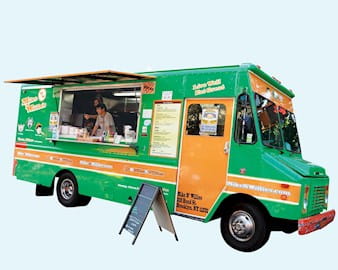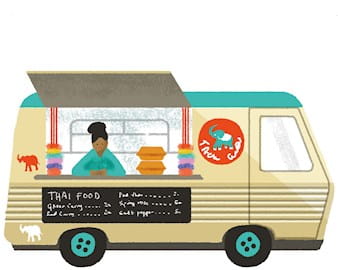
We asked three experts who think about this professionally (not just at lunchtime): a student, a professor, and an alumnus.
- By
- October 10, 2015
- Entrepreneurship

Eliot Abrams, BA ’12, is working on a PhD in economics at Booth. For his summer project, he studied how food trucks in Chicago choose their locations.

Pursuing a love of food and cooking, I completed the basic pastry certificate at Le Cordon Bleu in Paris the summer before starting the PhD program. So I was thrilled to see a crêpe truck, Paris Ouh La La, serving lunch during the school year. After several good meals at the food trucks on Ellis Avenue, and observing the variation in the trucks parked each day, I started thinking about how the trucks decide where to park.
Where you choose to locate a business is a fundamental economic question—one that food trucks must re-answer every day. The classic location choice model was offered by the mathematician and economist Harold Hotelling in 1929. Consider two ice cream vendors who parked their carts on a one-mile stretch of beach. Assuming the venders offer roughly the same treats, beachgoers will naturally choose to walk to the closest cart. The vendor on the left will serve all the beachgoers to its left, and the vendor on the right will serve all the beachgoers to its right. Knowing this, the vendors should both choose to locate at the middle of the beach in order to maximize their respective market shares and profit. Thus, Hotelling found that competition will lead vendors to congregate in the center.
“After several good meals, I started thinking about how the trucks choose their locations.”
His law explains why food trucks park right next to each other rather than spreading out along a block or across several city blocks. However, the law doesn’t explain why food trucks choose different parking locations on different days. The parking patterns of food trucks suggest an expanded model that incorporates additional influences: how consumers vary their lunch options, and also how they may develop, and then may lose the habit of patronizing a food truck.
Modeling food truck parking locations is complex, as there are around 70 active food trucks parking at more than 30 locations in Chicago. Thankfully, there is plenty of data because food trucks need to advertise their locations. Since 2011, Andrew Violette, who runs ChicagoFoodTruckFinder.com, has been tracking the city’s food trucks based on their Twitter feeds. I pulled 34,328 parking records from Violette’s website and created a simulation of how food trucks park.
This exercise translates the observed food truck movements into information on the relative number of customers a truck serves at each location on a given day. The number of customers is a function of many variables, such as the day of the week and the location chosen by the truck. I focus on estimating how customer traffic is impacted by the number and diversity of other trucks parking at the location and by the past frequency with which the truck has parked at the particular location. Just like Hotelling’s ice cream vendors, food trucks should (and do) choose their locations in response to these dynamics in order to maximize their profit.
Chad Syverson, J. Baum Harris Professor of Economics, researches the interactions of firm structure, market structure, and productivity.
There are three things to consider: cost, demand, and competition, or what you could call strategic interaction.
The cost side is pretty straightforward, unless there are big differences in parking costs or travel times. All else being equal, you want to be close to your home base where the food is prepared. Other than that, it doesn’t matter where you’re located. Your costs will be the same.
The demand side is more interesting. You want to be located where people will be looking to eat. That’s true for any food-service business. But of course competitors will want these spots too. There’s a trade-off between being where the demand is, with lots of competitors close at hand, and being a little further away but with less direct competition. That’s especially salient here because the trucks can literally chase their business, moving around day to day to meet demand. In that sense, they face the same decision over and over.
In terms of strategic interaction, an interesting feature of the food truck market—and some other markets—is that demand can be generated by the presence of sellers. There’s a benefit to being around other food trucks. Stationary food courts in malls and such work the same way. The restaurants compete with each other, but the larger overall food court is a magnet. There’s a location where people go because they want options. It’s called an agglomeration economy—the density of the sellers is a draw in and of itself.
“You don’t want to be one of 10 Thai food trucks. You want to be the only one selling Thai food among 10 trucks.”
The ideal situation here is to be one of many trucks but the only one selling your particular type of food. You don’t want to be one of 10 Thai food trucks. You want to be the only one selling Thai food among 10 trucks. The exception is for the brands that are so popular they’re a destination in themselves. In that case, there’s far less appeal in the density of the food court model because they can draw their own traffic without having to face the competition.
Note too that this is pretty distinct to the food industry. It’s a whole different scenario for, say, retailers that are located close to each other. They can actually complement each other. You could buy something at Crate & Barrel, for instance, and then buy something else at The Container Store. But in the food market, one lunch is a complete substitute for another lunch. Even then, however, there’s an argument that if you locate your truck by others, you’ll still take advantage of their collective drawing power. The human factor here is no small thing either. A lot of the time people just don’t know what they want when they go to lunch, making them more apt to visit a location with many choices.
Drew Davis, ’14, is chief operating officer and general manager of Eastman Egg Co., a Chicago restaurant and food truck that serves locally sourced breakfast sandwiches and coffee. Booth student Hunter Eastman Swartz took a leave from the program to launch Eastman Egg in 2013; Davis came onboard the following year and runs the day-to-day operations.
Our food truck parks in different spots depending on the day of the week. On weekdays, we tend to hang out in the Loop, because the Monday-to-Friday demand is in the business district. On Saturdays, we consistently go to the same spot in the West Loop, which is more residential. On Sundays, we’re always in the same place, a small shopping area in residential Wrigleyville.
There are a couple of factors that go into picking a location. A major consideration is the regulatory environment. In Chicago, food trucks are required to be 200 feet away from any restaurant or store with a commercial food license, which includes even convenience stores. The only exception to this rule is a small number of designated food truck zones. Truck owners have to find the right intersection of a designated spot or a place that complies with those regulations. It’s not that the rules are hard. It’s just that there are a limited number of financially viable spots.
In the Loop, the biggest thing you’re looking for is natural foot-traffic patterns.
“We’d much rather make ourselves part of people’s everyday experience, a part of their lives.”
That’s really a function of entry and exit from public transportation. You can look at a Chicago Transit Authority map and see which stations have the largest number of lines passing through them. Those tend to correlate with a high volume of foot traffic. It’s simple, and that’s where you’re going to see good results.
Elsewhere, and on weekends when people’s behavior is less predictable, deciding where to locate our truck involves a great deal of trial and error. We can’t really use neighborhood demographics to figure it out. Instead, we track patterns of behavior and find a convenient place to insert ourselves into the equation of someone’s morning. In the West Loop, we park near a dog park. If you have a dog, you have to get up and walk the dog. That’s your routine, and we’d like to make ourselves a part of it. This is also an active community—lots of yoga studios and people outside walking and running, so they see our truck.

In Wrigleyville, we ended up getting a lot of people out for Sunday strolls, running errands. We’re near a drugstore and a grocery store. By experimenting, we got to the right answer. We don’t want to be a destination in itself. We’d much rather make ourselves part of people’s everyday experience, a part of their lives.
At Booth, there’s always the question: Does the data exist and can I get it? I could generate data from our truck sales. But you can really only compare results if the day of the week was the same, the spot was the same, and the weather was the same. By the time you’ve made all those cuts in the data, the analysis would be horrendous. I work much better with stories. Understanding the use case of a Saturday or Sunday makes tremendous sense to me. If I could do that with five trucks in five cities, I could write a compelling business case for the “right” way to think about positioning food trucks.

With his growing fintech startup, Fundall, Kolapo Joseph, ’18 (EXP-23), is helping Africans spend, manage, and grow their money smartly.
Building Trust for Fintech in West Africa
Three Booth experts tell us what they think can get the engines revving again.
Why Is Productivity Stuck in Neutral?
AMOpportunities cofounder and 2017 NVC winner Kyle Swinsky explains how he connects international medical students with US physicians.
Med Students without Borders